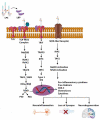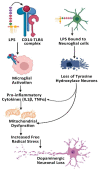Role of Endogenous Lipopolysaccharides in Neurological Disorders
- PMID: 36552802
- PMCID: PMC9777235
- DOI: 10.3390/cells11244038
Role of Endogenous Lipopolysaccharides in Neurological Disorders
Abstract
Lipopolysaccharide (LPS) is a cell-wall immunostimulatory endotoxin component of Gram-negative bacteria. A growing body of evidence reveals that alterations in the bacterial composition of the intestinal microbiota (gut dysbiosis) disrupt host immune homeostasis and the intestinal barrier function. Microbial dysbiosis leads to a proinflammatory milieu and systemic endotoxemia, which contribute to the development of neurodegenerative diseases and metabolic disorders. Two important pathophysiological hallmarks of neurodegenerative diseases (NDDs) are oxidative/nitrative stress and inflammation, which can be initiated by elevated intestinal permeability, with increased abundance of pathobionts. These changes lead to excessive release of LPS and other bacterial products into blood, which in turn induce chronic systemic inflammation, which damages the blood-brain barrier (BBB). An impaired BBB allows the translocation of potentially harmful bacterial products, including LPS, and activated neutrophils/leucocytes into the brain, which results in neuroinflammation and apoptosis. Chronic neuroinflammation causes neuronal damage and synaptic loss, leading to memory impairment. LPS-induced inflammation causes inappropriate activation of microglia, astrocytes, and dendritic cells. Consequently, these alterations negatively affect mitochondrial function and lead to increases in oxidative/nitrative stress and neuronal senescence. These cellular changes in the brain give rise to specific clinical symptoms, such as impairment of locomotor function, muscle weakness, paralysis, learning deficits, and dementia. This review summarizes the contributing role of LPS in the development of neuroinflammation and neuronal cell death in various neurodegenerative diseases.
Keywords: endotoxemia; gut microbiota; gut–brain axis; lipopolysaccharide; neurodegeneration; neuroinflammation.
Conflict of interest statement
The authors declare no conflict of interest.
Figures




Similar articles
-
Gut dysbiosis, defective autophagy and altered immune responses in neurodegenerative diseases: Tales of a vicious cycle.Pharmacol Ther. 2022 Mar;231:107988. doi: 10.1016/j.pharmthera.2021.107988. Epub 2021 Sep 16. Pharmacol Ther. 2022. PMID: 34536490 Review.
-
Gut Microbiota Interact With the Brain Through Systemic Chronic Inflammation: Implications on Neuroinflammation, Neurodegeneration, and Aging.Front Immunol. 2022 Apr 7;13:796288. doi: 10.3389/fimmu.2022.796288. eCollection 2022. Front Immunol. 2022. PMID: 35464431 Free PMC article. Review.
-
Intestinal dysbiosis causes spatial memory impairment in alcohol-exposed male mice by inducing neuroinflammation.Exp Neurol. 2025 Jan;383:115028. doi: 10.1016/j.expneurol.2024.115028. Epub 2024 Oct 28. Exp Neurol. 2025. PMID: 39490622
-
Platelets bridging the gap between gut dysbiosis and neuroinflammation in stress-linked disorders: A narrative review.J Neuroimmunol. 2023 Sep 15;382:578155. doi: 10.1016/j.jneuroim.2023.578155. Epub 2023 Jul 25. J Neuroimmunol. 2023. PMID: 37523892 Review.
-
Neuroinflammation: A Distal Consequence of Periodontitis.J Dent Res. 2022 Nov;101(12):1441-1449. doi: 10.1177/00220345221102084. Epub 2022 Jun 16. J Dent Res. 2022. PMID: 35708472 Free PMC article. Review.
Cited by
-
Newer Therapeutic Approaches in Treating Alzheimer's Disease: A Comprehensive Review.ACS Omega. 2025 Feb 3;10(6):5148-5171. doi: 10.1021/acsomega.4c05527. eCollection 2025 Feb 18. ACS Omega. 2025. PMID: 39989768 Free PMC article. Review.
-
Contributing roles of mitochondrial dysfunction and hepatocyte apoptosis in liver diseases through oxidative stress, post-translational modifications, inflammation, and intestinal barrier dysfunction.Cell Mol Life Sci. 2024 Jan 12;81(1):34. doi: 10.1007/s00018-023-05061-7. Cell Mol Life Sci. 2024. PMID: 38214802 Free PMC article. Review.
-
Extracellular Vesicle-Derived MicroRNAs as a Biomarker for Therapeutic Response in Multiple Sclerosis.Neurol Neuroimmunol Neuroinflamm. 2025 Jul;12(4):e200420. doi: 10.1212/NXI.0000000000200420. Epub 2025 Jun 19. Neurol Neuroimmunol Neuroinflamm. 2025. PMID: 40537080 Free PMC article.
-
Gut Microbial Metabolome and Dysbiosis in Neurodegenerative Diseases: Psychobiotics and Fecal Microbiota Transplantation as a Therapeutic Approach-A Comprehensive Narrative Review.Int J Mol Sci. 2023 Aug 27;24(17):13294. doi: 10.3390/ijms241713294. Int J Mol Sci. 2023. PMID: 37686104 Free PMC article. Review.
-
Epigallocatechin-3-Gallate, Quercetin, and Kaempferol for Treatment of Parkinson's Disease Through Prevention of Gut Dysbiosis and Attenuation of Multiple Molecular Mechanisms of Pathogenesis.Brain Sci. 2025 Jan 31;15(2):144. doi: 10.3390/brainsci15020144. Brain Sci. 2025. PMID: 40002477 Free PMC article. Review.
References
-
- Bojkovic J., Richie D.L., Six D.A., Rath C.M., Sawyer W.S., Hu Q., Dean C.R. Characterization of an Acinetobacter baumannii LptD Deletion Strain: Permeability Defects and Response to Inhibition of Lipopolysaccharide and Fatty Acid Biosynthesis. J. Bacteriol. 2016;198:731–741. doi: 10.1128/JB.00639-15. - DOI - PMC - PubMed
Publication types
MeSH terms
Substances
LinkOut - more resources
Full Text Sources
Medical

